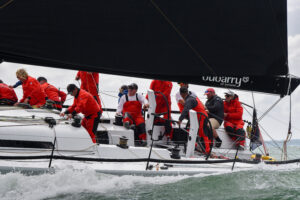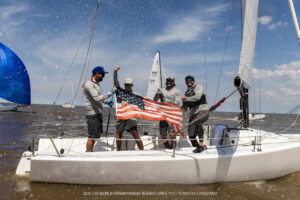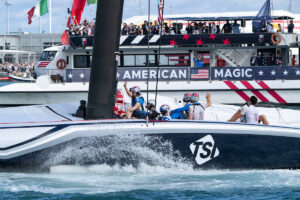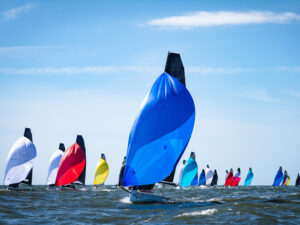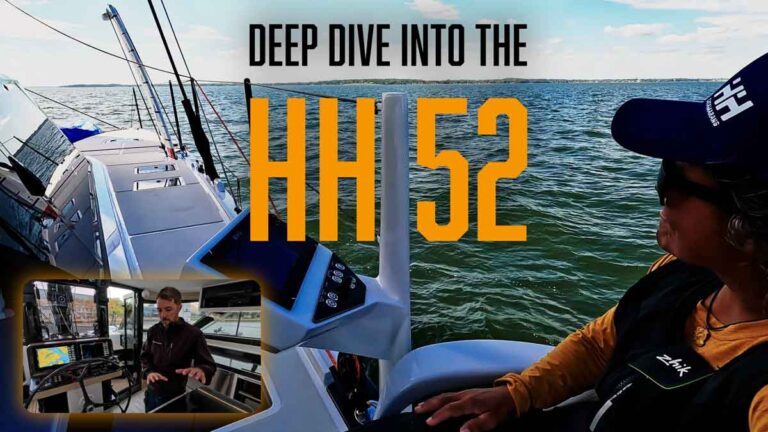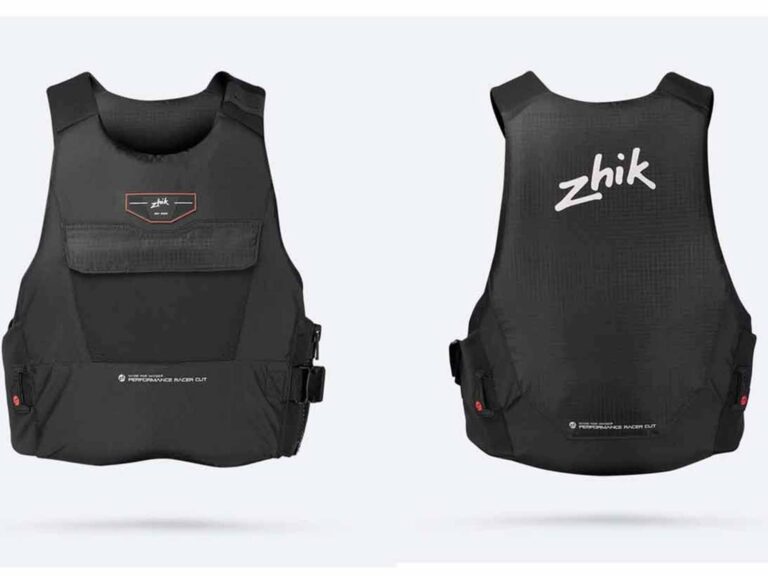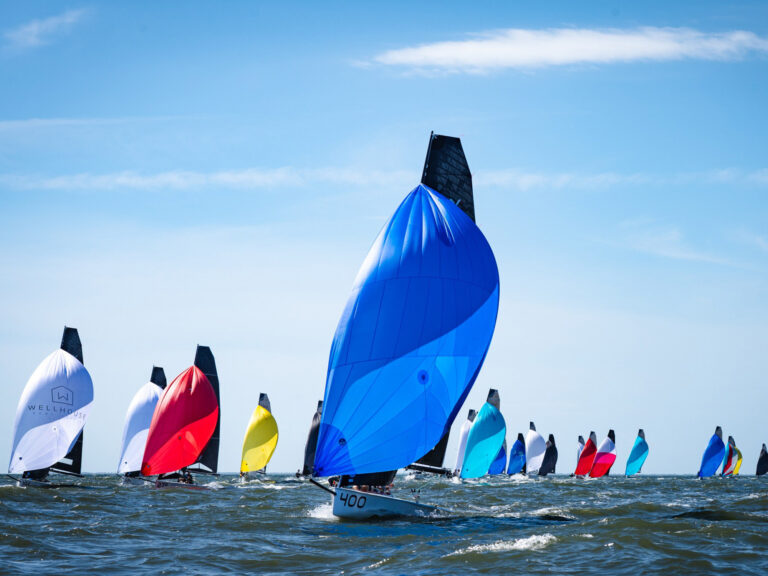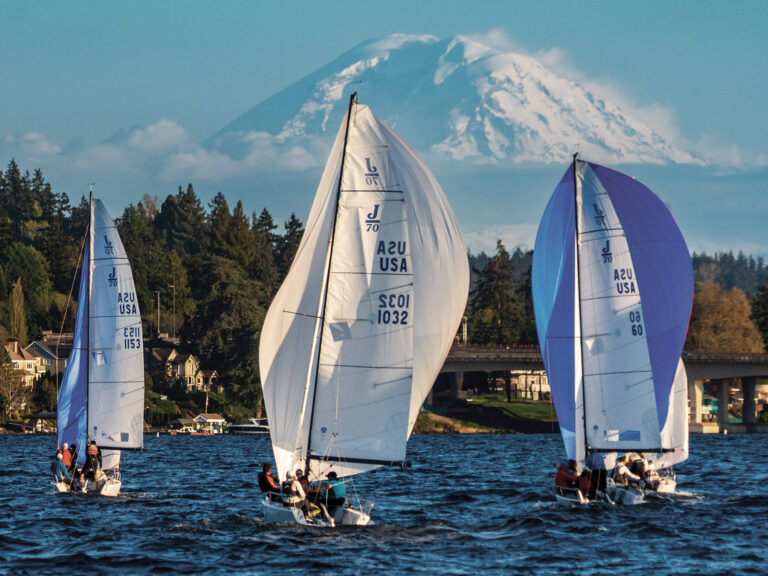
120408_VOR_PUMA
**“We heard a loud bang, and then in slow motion we saw the mast fall over the side.” **Groupama’s bowman, Brad Marsh recalls of the moment their team went from leading Leg 5 to becoming the race’s latest casualty. It was a bang heard around the world, as critics called the attrition rate in this leg unacceptable. Volvo Ocean Race CEO Knut Frostad was even forced to issue a public statement concerning the safety of the Volvo 70 design. “It is not acceptable that in a race like this we have so many failures. It is not unusual for boats to suffer problems, and sailors and shore teams are used to having to deal with some issues with their boats, but this has been on a bigger scale than in the past.” Has this race become too dangerous? Is the Volvo 70 really as fragile as the critics contend? Let’s not go throwing the boat out with the bilge water just yet.
This is the third Volvo Ocean Race to use the VO 70 design, a design specifically created to unleash the fastest, most powerful monohull yachts to ever conquer the world’s oceans. In that sense, they have been nothing short of amazing in terms of performance. Ericsson 4 is still the world’s fastest monohull, and she took the record from ABN AMRO 2, another Volvo 70 from the 2005 race. Not even the 100-foot behemoth Rambler 100 (née Speedboat) has been able to match the performance of these boats. I have been fortunate enough to sail on a few of these boats, and the raw power is intoxicating. On one trip, with a reefed main and the small J4 jib, we were effortlessly blasting along at speeds approaching 25 knots. Once, while wiping the stinging salt spray from my eyes, the thought occurred to me that had we been really racing in the open ocean, the boat would be doing 30 knots, and every wave would be a launch pad. Would I still want to go across the open ocean in a Volvo 70? Absolutely, but not without a sense of trepidation that I’ve never felt on any other boat. The boats demand respect and constant attention, and knowing when to turn the power down is paramount.
No one ever said these boats would be easy from a design standpoint either. The first generation of these boats suffered from a rash of keel problems. The design space was wide open and too many engineers opted to try to save weight in the keel-cant mechanism using small diameter carbon pushrods. The design rule also pushed teams to create keel wet box designs that were unsafe. As a result, keel issues and the sinking of Movistar forever marred the debut of these amazing yachts. (ABN AMRO 2 crewmember Hans Horrevoets also lost his life in a tragic accident during that race. A memorial fund for his family still exists, and a race award was created in his honor.)
For the 2009 race, design rules around the keel canting mechanism were dramatically changed to increase the safety factor, resulting in a much more trouble-free race. Even with rule changes, teams still broke rudders and suffered from panel delamination. That’s just part of the race. Endurance races are meant to test the physical limits of the competitors and the equipment they use. Not everyone finishes the Boston Marathon, or the 24 Hours of LeMans auto race. In yacht racing, only 50 percent of the last Vendée Globe finished. The Class 40 Global Ocean Race has also lost half of its competitors. Attrition has to be expected, and no rule will ever eliminate it.
So what has changed in this race to account for the extra damage? There have been two major cases of failure in the current Volvo. The first is mast failure, and the second has been structural delamination of the hull. Right now, there have been four mast failures in the race: Abu Dhabi Ocean Racing (Future Fibres), PUMA Ocean Racing (Hall), Sanya (Future Fibres), and now Groupama (Lorima spar, Future Fibres rigging). Of those failures, the only public comment has been from PUMA, where they seem to believe that a metal fastener failed, causing the rig to drop. From the other teams, we can only infer that the failures were due to the rigging, since both Abu Dhabi and Sanya have changed out their rigging packages. This is the first race to allow carbon standing rigging (VO 70 Rule 10.16.1), an area where Future Fibres has been working to push the limits on continuous molded carbon rigging. [Correction: This is not the first VO 70 race to allow carbon rigging. In the 2008/2009 edition all seven yachts that completed the full race were equipped with Southern Spars EC6 Carbon Rigging product, and there were no rig failures.] While teams have been busy exploring new rigging, mast designers also have had the opportunity to now work with high modulus carbon fiber (392 GPa verses the previous 300 GPa for you engineers out there) (VO 70 Rule 10.15.7). By using higher modulus materials, mast tube sections can be made smaller but with the same amount of stiffness, or greater overall stiffness can be achieved. Since none of the failures seem to be caused by mast tube compression failure, the most likely cause of the mast issues is in the carbon rigging. I don’t expect to see carbon rigging banned in the next race, but I do hope the manufacturers all release engineering assessments of the failures so that everyone’s product offerings can be improved.
When addressing the issue of hull delamination, things become far more complex. Both CAMPER and Abu Dhabi Ocean Racing pulled into Chile to fix damage to their hulls due to delamination. Telefonica had a similar issue, but the damage was less widespread, requiring just a short pit stop to pick up more material to reinforce their hull. (There is a great video here, showing the damage and repair encountered during Leg 5 and beyond.)
Already, the Volvo 70 rule requires boats to be built above and beyond the requirements of every international insurance rule (ABS, Lloyds, ISO). So why are the hulls breaking? A modern composite hull is a sandwich of two layers of carbon fiber with a core of either foam or Nomex in between. When subjected to high dynamic slamming loads, the bond between the carbon and core fails, and the panel loses its structural rigidity. Since the loads created by dynamic means are of a force-squared variety, a doubling of boatspeed increased the loads by a factor of 4. In the case of Abu Dhabi Ocean Racing, they fell off a wave at speeds around 41 knots. The hull saw an instant dynamic loading some 1,600 times the normal force! Unless the hull was built from an inch of reinforced steel, nothing was going to save them from major damage. That’s the nature of ocean racing sometimes. CAMPER’S failure likely occurred during a similar situation. If the design rule can’t possibly account for every failure scenario, how does the crew keep the boats in one piece then? The answer lies in either slowing the boat down so that the dynamic loads don’t become extreme, or avoiding the weather where damage can occur. For this leg, it was impossible to avoid the worst of the Southern Ocean wind and sea state due to ice gates mandated by the Race Committee. Due to a large amount of ice, the teams were forced to sail much further north than they would have liked. When the storms hit, the boats got caught in them, and unlike slower boats, were caught in them for days. If it weren’t for the ice gates, every navigator in the fleet would have sent their boats south to avoid being caught in the Southern Ocean washing machine. The Volvo Ocean Race isn’t alone in mandating ice gates. A similar situation caused the retirement of half of the Class 40 Global Ocean Race just over a month ago.
Winning any endurance race requires common sense. In the case of the Volvo Ocean Race, common sense needs to come from the Race Management, as well as from the designers, builders, and sailors. Let’s hope common sense prevails when revisions are made to the Volvo 70 rule. It’s a good rule that needs common sense from Race Management to properly execute. When it works, it works amazingly. This has been the closest racing in the history of the event, and as I write this, PUMA Ocean Racing is doing everything they can to hold off Telefonica in the final miles of Leg 5. (PUMA won the leg–its first win in two Volvo Ocean Races, by 13 minutes). Any rule that produces a match race after 6,500 miles of Southern Ocean racing can’t be that bad, can it?

